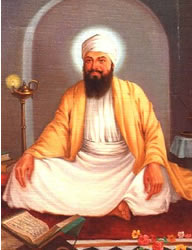 |
Guru
Tegh Bahadur |
The man who was to become the ninth Sikh guru—Tegh Bahadur (1621-75 CE)—was schooled in languages and religious knowledge and trained as a warrior. After the death of his father, he settled in Bakala, near Amritsar, to concentrate on meditation.
When the third guru, Amar Das, appointed his son, Ram Das, to succeed him, the position had become hereditary. However when the eighth guru, Har Krishan, died, he was still only a child. Before his death, he hinted that his successor would be found in Bakala. This caused an influx of hopefuls to the place, and the story is told that a devotee whose ship had been saved from sinking pledged 500 guineas to the new guru. However, when he turned up at Bakala he was shocked to discover twenty-two contenders.
He decided to offer a few guineas to each, including Tegh Bahadur, who asked, on receiving the guineas, why it was only five when the pledge had been 500. On hearing this the devotee was overwhelmed with joy, shouting from the rooftops, “I have found the Guru, I have found the Guru!”
Tegh Bahadur is most well-known for surrendering his life for the right of religious freedom, and each year a gurpurb is held to honour this sacrifice. In 1669 CE the Mughal Emperor Aurangzeb issued a general order that all non-Muslim schools and shrines should be destroyed. The persecution and forced conversions of the Hindus became intolerable to Tegh. In the face of increasing tyranny he decided to confront the Emperor; before leaving for Delhi, he appointed his son Gobind Das—later Gobind Singh—as his successor. He was subsequently executed by the Mughals for refusing to convert to Islam and standing firm for the rights of individuals to worship as they pleased.
His son and successor came to the conclusion that, when confronted with such tyranny, the people must rise in revolt. Gobind Singh’s greatest need was to create a national army, and this objective was achieved by the creation of the khalsa, the body of initiated believers. Over the next hundred years the people who had been dominated for centuries turned into formidible warriors, not only ending the rule of the Mughals but also putting a stop to invasions from the north-west.
Sikhs remember the Martyrdom of Tegh Bahadur with an akhand path, a complete and continuous reading of scripture that takes 48 hours and finishes on the day of the festival. The gurdwara is decorated, and worshippers dress up in new or smart clothes and join together for special services.